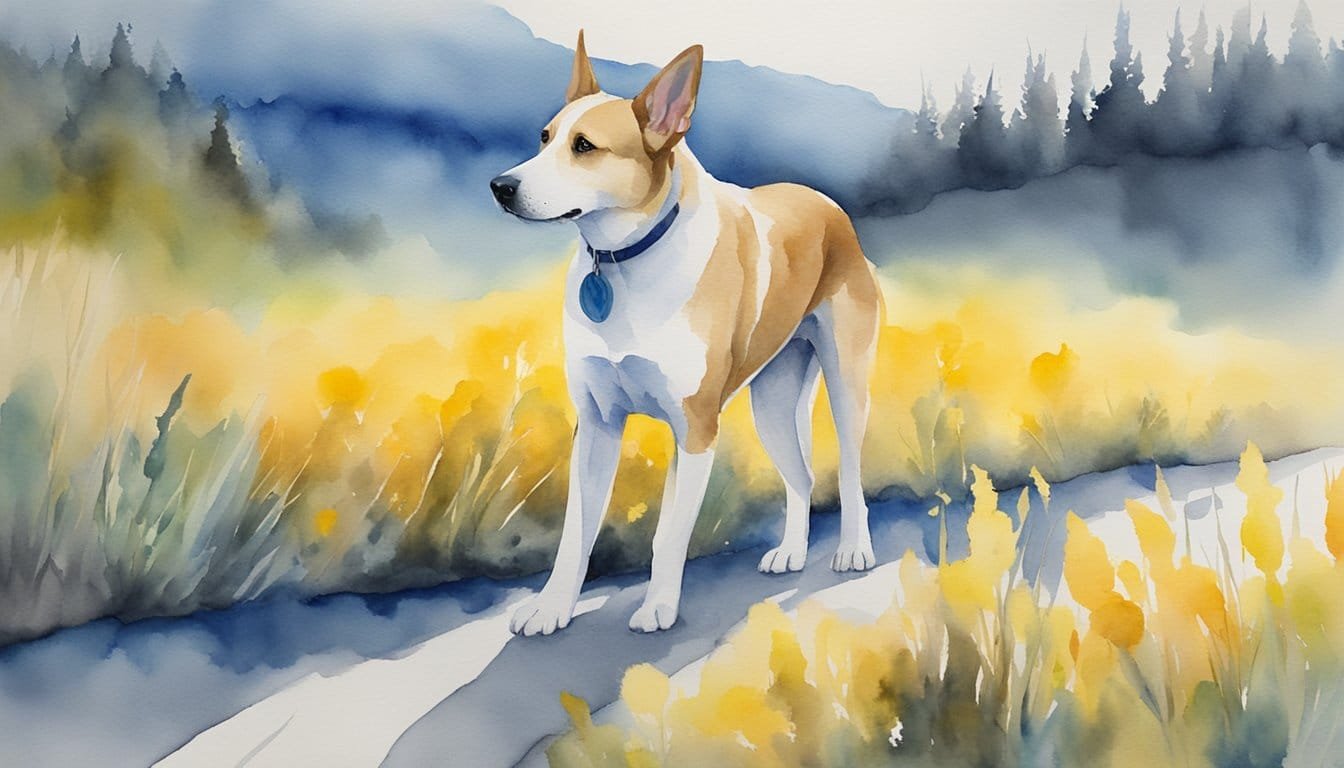Understanding Dog Vision
When uncovering the mysteries of how dogs perceive the world, it’s essential to focus on their color perception and the biology of their eyes. Here’s a peek into the fascinating world of canine sight.
Color Vision in Dogs
Contrary to popular belief, dogs are not completely colorblind—they actually experience the world with dichromatic vision. This means they can see two colors. Humans, on the other hand, typically have trichromatic vision, allowing them to see a full spectrum of colors. In dog’s vision, the colors they perceive are similar to what a human with red-green colorblindness would see; they can make out blues and yellows, but reds and greens are tricky and may appear as grays or blends of the two colors they can discern.
Known Colors Dogs Can See:
- Blue
- Yellow
Colors Dogs Struggle With:
- Red
- Green
Cones and Rods: The Science Behind Canine Sight
The canine eye houses two main types of photoreceptors: cones and rods. Cones are responsible for color vision and function best in bright light, whereas rods are more sensitive and can pick up low levels of light, aiding in night vision. Dogs have a higher density of rods compared to humans, which makes their night vision superior. However, this comes at a cost to their visual acuity and color discernment. Additionally, they have a specialized layer in their eyes called the tapetum lucidum, which reflects light back through the retina, further enhancing their ability to see in the dark.
Components of Canine Eyes:
- Cones: Color vision, less numerous
- Rods: Low-light vision, more numerous
- Tapetum Lucidum: Reflective layer for night vision
Through understanding the cones and rods in dogs’ eyes, we get a clearer picture of their strengths and limitations in sight—excelling in night vision but experiencing a more muted palette of colors.
Comparing Dog and Human Vision

When we think of the world seen through the eyes of a dog, it’s important to remember that their color spectrum is vastly different from our own. Understanding these differences sheds light on how man’s best friend perceives their surroundings.
The Range of Colors Dogs Can See
Dogs certainly see color, but not in the same way humans do. Research shows that dogs have dichromatic vision, meaning they have two types of color receptors, or cones, in their eyes. These allow them to see shades of blue and yellow effectively, but make them unable to recognize red and green as these fall outside their perception range. On the other hand, the ability to notice violet hues exists, adding a bit more depth to their world. This is similar to human red-green color blindness, although dogs naturally experience the world this way. An example of how dogs perceive color can be found in the study on domestication as a potential driver of iris colour.
Canine vs. Human Color Perception
Humans have trichromatic vision, which permits them to see a full spectrum of colors including red, yellow, green, blue, and violet. This wide range is thanks to the presence of three types of cone cells each sensitive to different wavelengths of light. Dogs, however, perceive a more limited palette due to their dichromatic vision. It’s not that dogs are completely color blind; rather, their color world is just less saturated and vibrant compared to that of humans. While humans might relish a rainbow’s gradation of seven distinct hues, dogs would see fewer variations, primarily in blues and yellows. Insights into dog vision and their discrimination of human and dog faces provide a glimpse into their world, as detailed in a study on visual paired comparison in dogs.
Practical Insights into Dog Vision

Dogs perceive the world differently from humans, especially when it comes to color vision. Understanding how dogs see can significantly enhance their lives, from selecting toys that cater to their visual capabilities to designing living spaces that they find comfortable.
Selecting Toys and Accessories
When choosing toys for dogs, it’s crucial to consider their dichromatic color vision. Dogs can see shades of blue and yellow more vividly than colors like red or green. Selecting toys in blues and yellows can make them more attractive and easier for dogs to locate during play. For example, a blue ball will stand out more to a dog in the green grass compared to a red one. Playtime is not only fun but also a key aspect of a dog’s behavior, promoting mental stimulation and physical exercise.
Designing Comfortable Living Spaces
A dog’s comfort at home or in the office environment is paramount. Beyond aesthetics, a living space should cater to a dog’s needs for safety and relaxation. Soft blues and yellows can be soothing colors for a dog’s bed or blanket. Additionally, clear pathways and uncluttered spaces help accommodate a dog’s perspective and the instinct to scan their environment, possibly a throwback to their days of spotting prey. Educating pet owners about dogs’ visual preferences can lead to happier pets and a more harmonious cohabitation.

